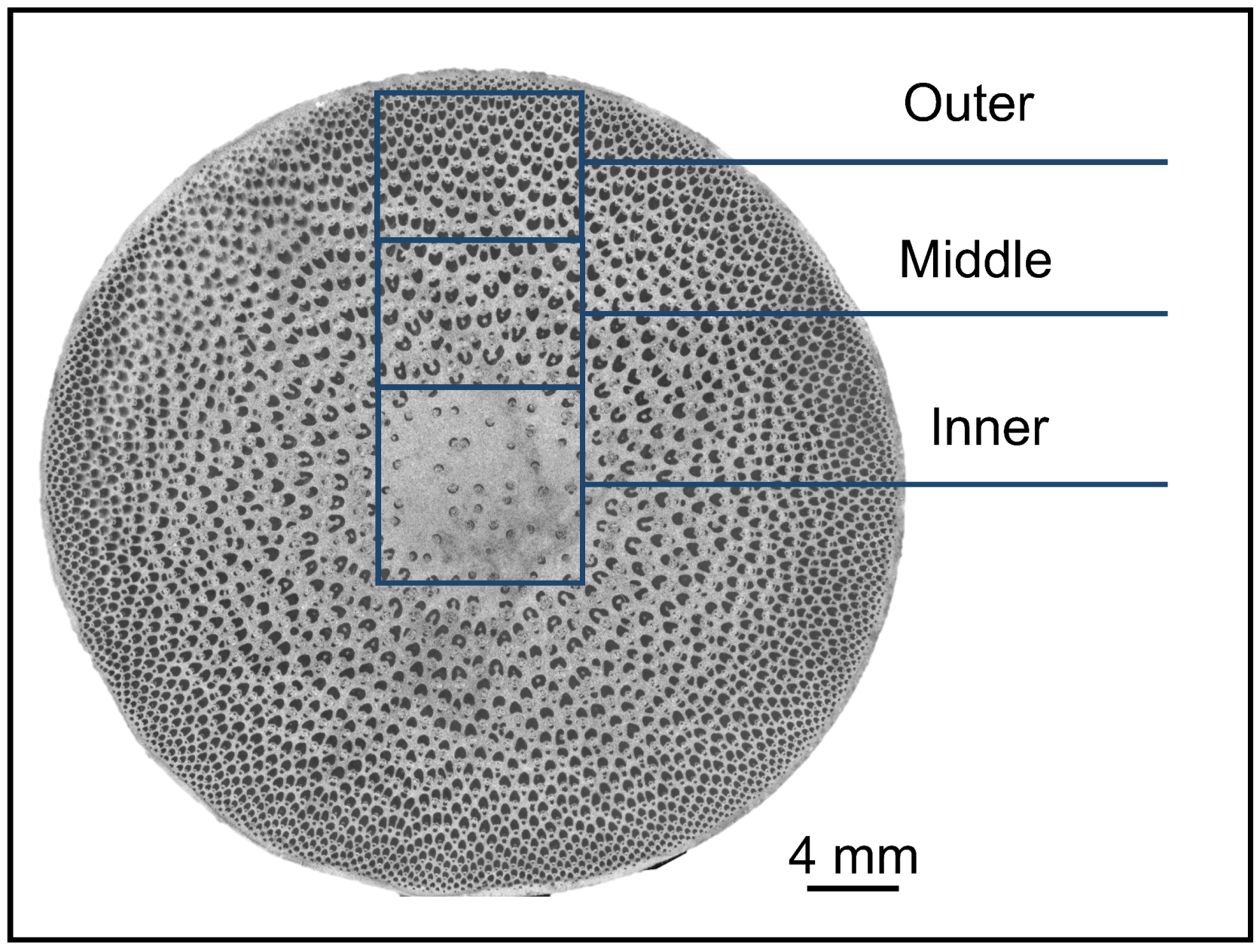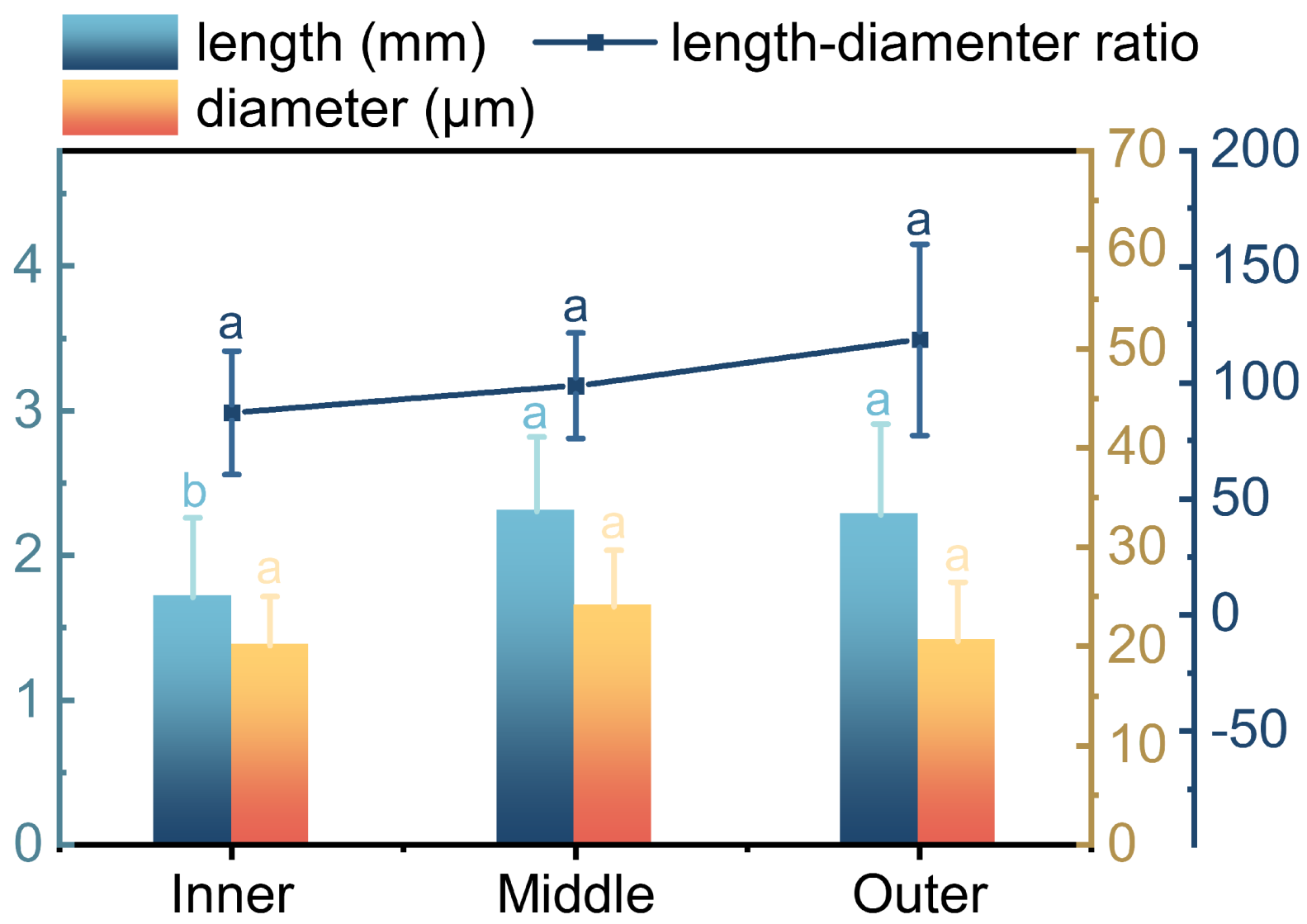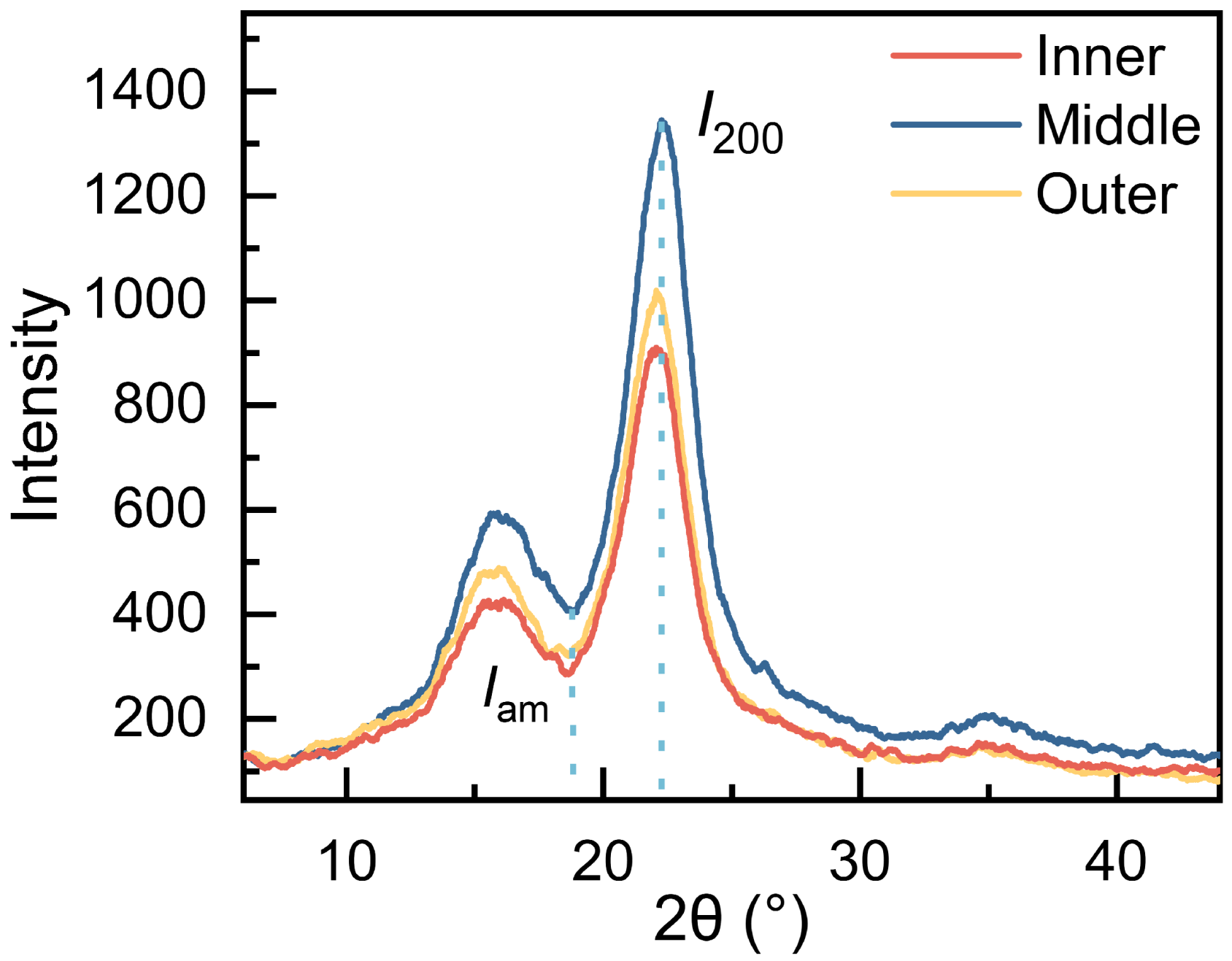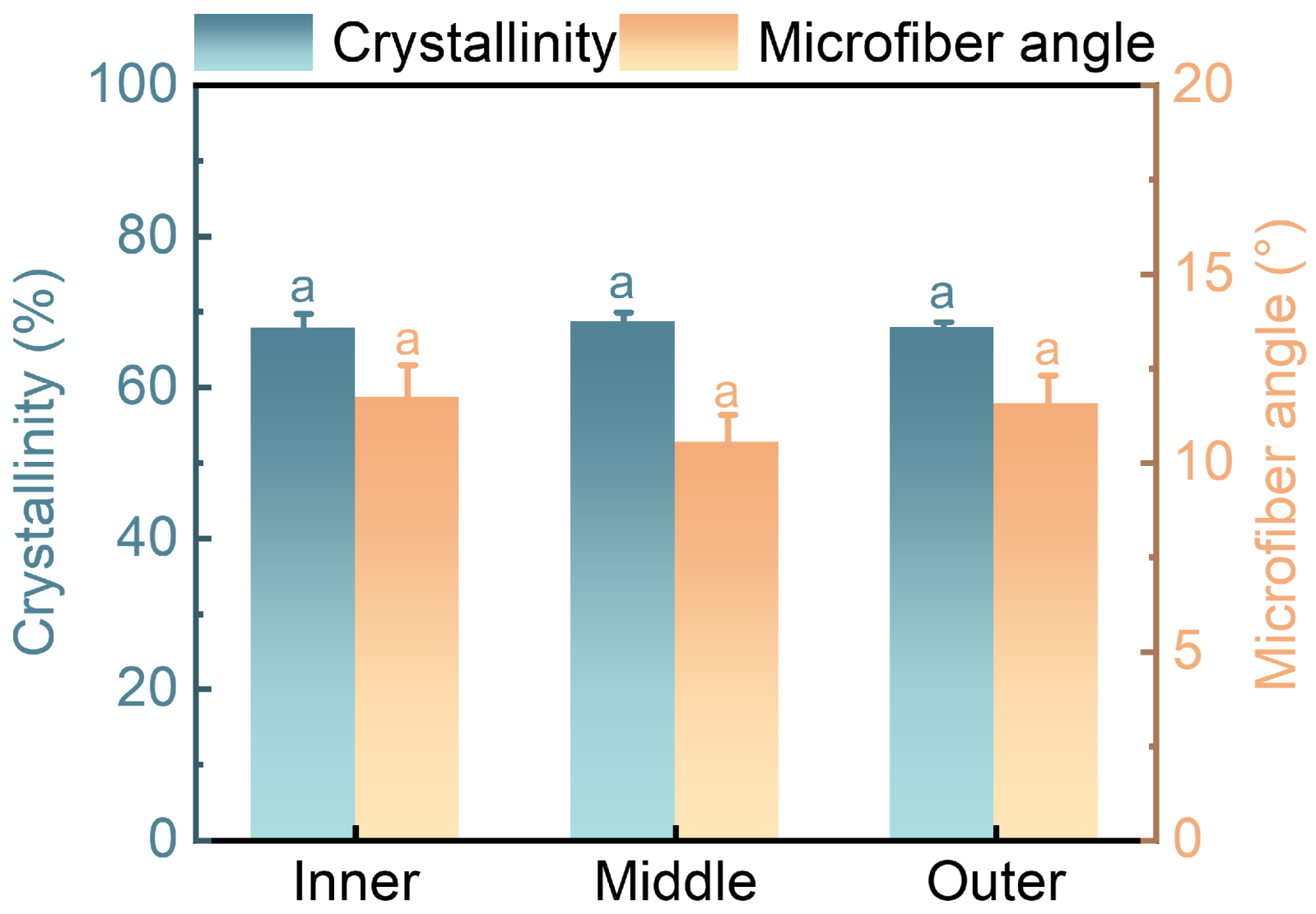Fiber Characteristics and Mechanical Properties of Oxytenanthera abyssinica
Abstract
:1. Introduction
2. Materials and Methods
2.1. Materials
2.2. SEM
2.3. Obtaining Frequency and Tissue Proportion
2.4. Maceration
2.5. X-ray Diffraction (XRD)
2.6. Nanoindentation Test
2.7. Data Analysis
3. Results and Discussion
3.1. Structure of Cross Section
3.2. The Frequency of Vascular Bundle and the Tissue Proportion of Fiber
3.3. Fiber Dimensions
3.4. Cellulose Crystallinity and Microfiber Angle
3.5. The Mechanical Properties of Fibers
4. Conclusions
Author Contributions
Funding
Data Availability Statement
Acknowledgments
Conflicts of Interest
References
- Xiang, E.; Yang, S.; Cao, C.; Liu, X.; Peng, G.; Shang, L.; Tian, G.; Ma, Q.; Ma, J. Visualizing complex anatomical structure in bamboo nodes based on X-ray microtomography. J. Renew. Mater. 2021, 9, 1531. [Google Scholar] [CrossRef]
- Gupta, A.; Kumar, A. Potential of bamboo in sustainable development. Asia Pac. Bus. Rev. 2008, 4, 100–107. [Google Scholar] [CrossRef]
- Liu, P.; Xiang, P.; Zhou, Q.; Zhang, H.; Tian, J.; Argaw, M.D. Prediction of mechanical properties of structural bamboo and its relationship with growth parameters. J. Renew. Mater. 2021, 9, 2223. [Google Scholar] [CrossRef]
- Borowski, P.F.; Patuk, I.; Bandala, E.R. Innovative industrial use of bamboo as key “Green” material. Sustainability 2022, 14, 1955. [Google Scholar] [CrossRef]
- Othman, S.A. Bamboo Plant: Benefit and Future; APS: St. Paul, MN, USA, 2023; p. 28. [Google Scholar]
- Embaye, K.; Christersson, L.; Ledin, S.; Weih, M. Bamboo as bioresource in Ethiopia: Management strategy to improve seedling performance (Oxytenanthera abyssinica). Bioresour. Technol. 2003, 88, 33–39. [Google Scholar] [CrossRef] [PubMed]
- Lian, C.; Zhang, G.; Feng, Y.; Ran, H.; Zhang, Y.; Guo, Q. Seed characters and genetic variation of Oxytenanthera abyssinica. Guangxi Zhiwu/Guihaia 2016, 36, 943–948. [Google Scholar]
- Zhun-Sheng, Y.; Yun-Feng, Z.; Le, K. Biomass of Oxytenanthera abyssinica in Benishangul-Gumuz State of Ethiopia. J. Bamboo Res. 2020, 39, 76–79. [Google Scholar]
- Mousavi, S.R.; Zamani, M.H.; Estaji, S.; Tayouri, M.I.; Arjmand, M.; Jafari, S.H.; Nouranian, S.; Khonakdar, H.A. Mechanical properties of bamboo fiber-reinforced polymer composites: A review of recent case studies. J. Mater. Sci. 2022, 57, 3143–3167. [Google Scholar] [CrossRef]
- Guan, M.; An, X.; Liu, H. Cellulose nanofiber (CNF) as a versatile filler for the preparation of bamboo pulp based tissue paper handsheets. Cellulose 2019, 26, 2613–2624. [Google Scholar] [CrossRef]
- Lin, Q.; Jiang, P.; Ren, S.; Liu, S.; Ji, Y.; Huang, Y.; Yu, W.; Fontaine, G.; Bourbigot, S. Advanced functional materials based on bamboo cellulose fibers with different crystal structures. Compos. Part A Appl. Sci. Manuf. 2022, 154, 106758. [Google Scholar] [CrossRef]
- Yao, W.; Zhang, W. Research on manufacturing technology and application of natural bamboo fibre. In Proceedings of the 2011 4th International Conference on Intelligent Computation Technology and Automation, Shenzhen, China, 28–29 March 2011; Volume 2, pp. 143–148. [Google Scholar]
- Chen, C.; Li, H.; Dauletbek, A.; Shen, F.; Hui, D.; Gaff, M.; Lorenzo, R.; Corbi, I.; Corbi, O.; Ashraf, M. Properties and Applications of Bamboo Fiber–A Current-State-of-the Art. J. Renew. Mater. 2022, 10, 605. [Google Scholar] [CrossRef]
- Chee, S.S.; Jawaid, M.; Sultan, M.; Alothman, O.Y.; Abdullah, L.C. Thermomechanical and dynamic mechanical properties of bamboo/woven kenaf mat reinforced epoxy hybrid composites. Compos. Part B Eng. 2019, 163, 165–174. [Google Scholar] [CrossRef]
- Bakar, N.; Chin, S.C. Performance of bamboo fiber reinforced composites: Mechanical properties. In Key Engineering Materials; Trans Tech Publications: Bäch, Switzerland, 2021; Volume 879, pp. 284–293. [Google Scholar]
- Xie, X.; Zhou, Z.; Jiang, M.; Xu, X.; Wang, Z.; Hui, D. Cellulosic fibers from rice straw and bamboo used as reinforcement of cement-based composites for remarkably improving mechanical properties. Compos. Part B Eng. 2015, 78, 153–161. [Google Scholar] [CrossRef]
- Gao, X.; Cheng, W.; Wang, H.; Han, G.; Li, Z. Effect of wood fiber geometry on the properties of wood-plastic composites. J. Northeast For. Univ. 2014, 42, 100–103. [Google Scholar]
- Peter, Z. Order in cellulosics: Historical review of crystal structure research on cellulose. Carbohydr. Polym. 2021, 254, 117417. [Google Scholar] [CrossRef] [PubMed]
- Bourmaud, A.; Morvan, C.; Bouali, A.; Placet, V.; Perre, P.; Baley, C. Relationships between micro-fibrillar angle, mechanical properties and biochemical composition of flax fibers. Ind. Crop. Prod. 2013, 44, 343–351. [Google Scholar] [CrossRef]
- Wang, X.; Chen, X.; Xie, X.; Wu, Y.; Zhao, L.; Li, Y.; Wang, S. Effects of thermal modification on the physical, chemical and micromechanical properties of Masson pine wood (Pinus massoniana Lamb.). Holzforschung 2018, 72, 1063–1070. [Google Scholar] [CrossRef]
- Burgert, I.; Keckes, J.; Frühmann, K.; Fratzl, P.; Tschegg, S. A Comparison of Two Techniques for Wood Fibre Isolation-Evaluation by Tensile Tests on Single Fibres with Different Microfibril Angle. Plant Biol. 2002, 4, 9–12. [Google Scholar] [CrossRef]
- Huang, Y.; Fei, B.; Wei, P.; Zhao, C. Mechanical properties of bamboo fiber cell walls during the culm development by nanoindentation. Ind. Crop. Prod. 2016, 92, 102–108. [Google Scholar] [CrossRef]
- Yuan, T.; Wang, X.; Lou, Z.; Zhang, T.; Han, X.; Wang, Z.; Hao, X.; Li, Y. Comparison of the fabrication process and macro and micro properties of two types of crack-free, flatten bamboo board. Constr. Build. Mater. 2022, 317, 125949. [Google Scholar] [CrossRef]
- Schneider, C.A.; Rasband, W.S.; Eliceiri, K.W. NIH Image to ImageJ: 25 years of image analysis. Nat. Methods 2012, 9, 671–675. [Google Scholar] [CrossRef] [PubMed]
- Segal, L.; Creely, J.J.; Martin, A., Jr.; Conrad, C. An empirical method for estimating the degree of crystallinity of native cellulose using the X-ray diffractometer. Text. Res. J. 1959, 29, 786–794. [Google Scholar] [CrossRef]
- Tamer, T.A.; Abdul Aziz, F.; Shahidan, R. A study of the nanostructure of the cellulose of acacia mangium wood by X-ray diffraction and small-angle X-ray scattering. In Advanced Materials Research; Trans Tech Publications: Bäch, Switzerland, 2012; Volume 364, pp. 480–484. [Google Scholar]
- Cave, I. Theory of X-ray measurement of microfibril angle in wood. Wood Sci. Technol. 1997, 31, 225–234. [Google Scholar] [CrossRef]
- Magazzù, A.; Marcuello, C. Investigation of soft matter nanomechanics by atomic force microscopy and optical tweezers: A comprehensive review. Nanomaterials 2023, 13, 963. [Google Scholar] [CrossRef] [PubMed]
- Oliver, W.C.; Pharr, G.M. An improved technique for determining hardness and elastic modulus using load and displacement sensing indentation experiments. J. Mater. Res. 1992, 7, 1564–1583. [Google Scholar] [CrossRef]
- Eder, M.; Arnould, O.; Dunlop, J.W.; Hornatowska, J.; Salmén, L. Experimental micromechanical characterisation of wood cell walls. Wood Sci. Technol. 2013, 47, 163–182. [Google Scholar] [CrossRef]
- Dai, F.; Wang, Z.; Zhong, T.; Wang, H.; Tian, G. Study of the Climbing Behavior of the Flagella of Calamus Simplicifolius Based on Micro-CT and Nanoindentation. J. Bionic Eng. 2022, 19, 1790–1796. [Google Scholar] [CrossRef]
- Dai, F.; Wang, Z.; Wang, H.; Zhang, W.; Zhong, T.; Tian, G. Vascular bundle characteristics and mechanical properties of Dendrocalamus sinicus. Constr. Build. Mater. 2023, 363, 129858. [Google Scholar] [CrossRef]
- Yu, Y.; Tian, G.; Wang, H.; Fei, B.; Wang, G. Mechanical characterization of single bamboo fibers with nanoindentation and microtensile technique. Holzforschung 2011, 65, 113–119. [Google Scholar] [CrossRef]
- Xing, D.; Li, J.; Wang, X.; Wang, S. In situ measurement of heat-treated wood cell wall at elevated temperature by nanoindentation. Ind. Crop. Prod. 2016, 87, 142–149. [Google Scholar] [CrossRef]
- Zwawi, M. A review on natural fiber bio-composites, surface modifications and applications. Molecules 2021, 26, 404. [Google Scholar] [CrossRef] [PubMed]
- Youssefian, S.; Rahbar, N. Molecular origin of strength and stiffness in bamboo fibrils. Sci. Rep. 2015, 5, 11116. [Google Scholar] [CrossRef] [PubMed]
- Shang, L.; Sun, Z.; Liu, X.; Jiang, Z. A novel method for measuring mechanical properties of vascular bundles in moso bamboo. J. Wood Sci. 2015, 61, 562–568. [Google Scholar] [CrossRef]
- Li, S.; Yang, S.; Shang, L.; Liu, X.; Ma, J.; Ma, Q.; Tian, G. 3D visualization of bamboo node’s vascular bundle. Forests 2021, 12, 1799. [Google Scholar] [CrossRef]
- Zakikhani, P.; Zahari, R.; Sultan, M.T.b.H.H.; Majid, D.L.A.A. Morphological, mechanical, and physical properties of four bamboo species. BioResources 2017, 12, 2479–2495. [Google Scholar] [CrossRef]
- Chen, H.; Zhang, W.; Wang, X.; Wang, H.; Wu, Y.; Zhong, T.; Fei, B. Effect of alkali treatment on wettability and thermal stability of individual bamboo fibers. J. Wood Sci. 2018, 64, 398–405. [Google Scholar] [CrossRef]
- Zha, R.; Chen, T.; Liu, Q.; Wei, Q.; Que, F. Morphological and Anatomical Analysis of the Internodes of a New Dwarf Variant of Moso Bamboo, Phyllostachys edulis f. exaurita. Plants 2023, 12, 1759. [Google Scholar] [CrossRef] [PubMed]
- Brito, F.M.S.; Paes, J.B.; Oliveira, J.T.d.S.; Arantes, M.D.C.; Fantuzzi Neto, H. Giant Bamboo (Dendrocalamus giganteus Munro) Anatomical and Physical Characterization. Floresta Ambient. 2015, 22, 559–566. [Google Scholar] [CrossRef]
- Javadian, A.; Smith, I.F.; Saeidi, N.; Hebel, D.E. Mechanical properties of bamboo through measurement of culm physical properties for composite fabrication of structural concrete reinforcement. Front. Mater. 2019, 6, 15. [Google Scholar] [CrossRef]
- Suhaimi, N.M.; Mohd Hassan, N.H.; Ibrahim, R.; Jasmani, L. Fiber morphology of different bamboo species and age. In Materials Science Forum; Trans Tech Publications: Bäch, Switzerland, 2021; Volume 1025, pp. 312–318. [Google Scholar]
- Esa, M.F.; Main, N.M.; Roslan, M.N.; Marsi, N.; Kamarudin, K.; Jasmani, L. A Narrative Review: Bamboo Fiber as an Alternative Source for Pulp and Paper. In Proceedings of the International Conference on Mechanical Engineering Research, Krakow, Poland, 11–13 December 2021; Springer: Berlin/Heidelberg, Germany, 2021; pp. 363–385. [Google Scholar]
- Area, M.C. Wood Fibres for Papermaking; Smithers Pira: Surrey, UK, 2014. [Google Scholar]
- Chen, M.; Dai, C.; Liu, R.; Lian, C.; Yuan, J.; Fang, C.; Fei, B. Influence of cell wall structure on the fracture behavior of bamboo (Phyllostachys edulis) fibers. Ind. Crop. Prod. 2020, 155, 112787. [Google Scholar] [CrossRef]
- Pulkkinen, I.; Ala-Kaila, K.; Aittamaa, J. Characterization of wood fibers using fiber property distributions. Chem. Eng. Process. 2006, 45, 546–554. [Google Scholar] [CrossRef]
- Wang, C.; Wang, N.; Liu, S.; Choo-Simth, L.P.; Zhang, H.; Zhi, Z. Investigation of microfibril angle of flax fibers using X-ray diffraction and scanning electron microscopy. J. Nat. Fibers 2020, 17, 1001–1010. [Google Scholar] [CrossRef]
- Poletto, M.; Ornaghi Junior, H.L.; Zattera, A.J. Native cellulose: Structure, characterization and thermal properties. Materials 2014, 7, 6105–6119. [Google Scholar] [CrossRef]
- Yuan, T.; Wang, Z.; Han, X.; Yuan, Z.; Wang, X.; Li, Y. Multi-scale evaluation of the effect of saturated steam on the micromechanical properties of Moso bamboo. Holzforschung 2021, 75, 1052–1060. [Google Scholar] [CrossRef]
- Ren, W.; Zhu, J.; Guo, F.; Guo, J.; Wang, H.; Yu, Y. Estimating cellulose microfibril orientation in the cell wall sublayers of bamboo through dimensional analysis of microfibril aggregates. Ind. Crop. Prod. 2022, 179, 114677. [Google Scholar] [CrossRef]
- Yang, X.; Tian, G.; Shang, L.; Lv, H.; Yang, S. Variation in the cell wall mechanical properties of Dendrocalamus farinosus bamboo by nanoindentation. BioResources 2014, 9, 2289–2298. [Google Scholar] [CrossRef]
- Huang, Y.; Fei, B. Comparison of the mechanical characteristics of fibers and cell walls from moso bamboo and wood. BioResources 2017, 12, 8230–8239. [Google Scholar] [CrossRef]
- Lo, T.Y.; Cui, H.; Tang, P.; Leung, H. Strength analysis of bamboo by microscopic investigation of bamboo fibre. Constr. Build. Mater. 2008, 22, 1532–1535. [Google Scholar] [CrossRef]
- Marcuello, C.; Chabbert, B.; Berzin, F.; Bercu, N.B.; Molinari, M.; Aguié-Béghin, V. Influence of Surface Chemistry of Fiber and Lignocellulosic Materials on Adhesion Properties with Polybutylene Succinate at Nanoscale. Materials 2023, 16, 2440. [Google Scholar] [CrossRef]








Disclaimer/Publisher’s Note: The statements, opinions and data contained in all publications are solely those of the individual author(s) and contributor(s) and not of MDPI and/or the editor(s). MDPI and/or the editor(s) disclaim responsibility for any injury to people or property resulting from any ideas, methods, instructions or products referred to in the content. |
© 2023 by the authors. Licensee MDPI, Basel, Switzerland. This article is an open access article distributed under the terms and conditions of the Creative Commons Attribution (CC BY) license (https://creativecommons.org/licenses/by/4.0/).
Share and Cite
Yu, L.; Dai, F.; Zhang, K.; Jiang, Z.; Xia, M.; Wang, Y.; Tian, G. Fiber Characteristics and Mechanical Properties of Oxytenanthera abyssinica. Plants 2023, 12, 2987. https://doi.org/10.3390/plants12162987
Yu L, Dai F, Zhang K, Jiang Z, Xia M, Wang Y, Tian G. Fiber Characteristics and Mechanical Properties of Oxytenanthera abyssinica. Plants. 2023; 12(16):2987. https://doi.org/10.3390/plants12162987
Chicago/Turabian StyleYu, Linpeng, Fukuan Dai, Kangjian Zhang, Zehui Jiang, Mingsong Xia, Youhong Wang, and Genlin Tian. 2023. "Fiber Characteristics and Mechanical Properties of Oxytenanthera abyssinica" Plants 12, no. 16: 2987. https://doi.org/10.3390/plants12162987




